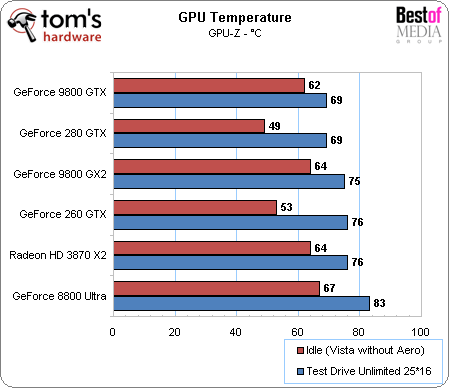Nvidia GeForce GTX 260/280 Review
Temperatures, Overclocking
With its low power consumption at idle and high-but-not-excessive consumption under load, we were relatively sure that with the GT200 Nvidia would maintain the reputation they’ve had since the GeForce 7800 GTX as a maker of relatively quiet high-end cards. We were wrong.

During Windows startup, the GT200 fan was quiet (running at 516 rpm, or 30% of its maximum rate). Then, once a game was started, it suddenly turned into a washing machine, reaching a noise level that was frankly unbearable – especially the GTX 280. The GTX 260 did slightly better, but also became noisy at 1250 rpm (the noise of the air flow, not of the fan itself). We should tell you, however, that our at-idle readings are taken after all our benchmarks have been run, after just a few minutes at idle. The problem is that the GTX 280 never really goes back to its minimum level, and the GTX 260’s fan, while it does better, still runs at 700 rpm – though that’s relatively quiet.
These results at idle are hard to understand given the GT200’s low at-rest power consumption, and must be the fault either of a problem with the BIOS (though it showed up on two different cards) or the drivers, which leaves hope for some progress. If not, it’ll still possible to slow the fan manually using special software, provided you keep an eye on temperatures (see the next page). Still, the fans are a big disappointment with these cards, especially when you consider that they blow part of the hot air back into the case and so contribute to heating it, which in turn causes the GPU fan to crank up, not to mention the other components.
Finally, we noted that, as in the case of power consumption, the results for the 3870 X2 under load were abnormally good, for the same reason: Test Drive Unlimited is one of the rare games with which only one of the card’s GPUs is really used, which limits heating.
Overclocking
In overclocking tests, we were able to push the GeForce GTX 260 from 576/1242/999 MHz (GPU/ALU/memory) to 648/1397/1184 MHz, or 12% and 18% respectively. That’s good, and let us squeeze out a gain of 16%, or 8.4 frames per second, at 2560*1600 with Test Drive Unlimited – only 6% slower than the GTX 280!
Except that obviously we overclocked it too – from 602/1296/1107 MHz to 655/1410/1290 with very good stability, for gains of 9% and 16%. Test Drive Unlimited again benefited from the boost with a 13% increase in frame rate – which is quite good even next to the 16% we got with the 9800 GTX. Overall, those results are very coherent, especially for overclocking, which is not an exact science.
Get Tom's Hardware's best news and in-depth reviews, straight to your inbox.
-
Lunarion what a POS, the 9800gx2 is $150+ cheaper and performs just about the same. Let's hope the new ATI cards coming actually make a differenceReply -
foxhound009 woow,.... that's the new "high end" gpu????Reply
lolz.. 3870 x2 wil get cheaper... and nvidia gtx200 lies on the shelves providing space for dust........
(I really expectede mmore from this one... :/ ) -
thatguy2001 Pretty disappointing. And here I was thinking that the gtx 280 was supposed to put the 9800gx2 to shame. Not too good.Reply -
cappster Both cards are priced out of my price range. Mainstream decently priced cards sell better than the extreme high priced cards. I think Nvidia is going to lose this round of "next gen" cards and price to performance ratio to ATI. I am a fan of whichever company will provide a nice performing card at a decent price (sub 300 dollars).Reply -
njalterio Very disappointing, and I had to laugh when they compared the prices for the GTX 260 and the GTX 280, $450 and $600, calling the GTX 260 "nearly half the price" of the GTX 280. Way to fail at math. lol.Reply -
NarwhaleAu It is going to get owned by the 4870x2. In some cases the 3870x2 was quicker - not many, but we are talking 640 shaders total vs. 1600 total for the 4870x2.Reply -
MooseMuffin Loud, power hungry, expensive and not a huge performance improvement. Nice job nvidia.Reply -
compy386 This should be great news for AMD. The 4870 is rumored to come in at 40% above the 9800GTX so that would put it at about the 260GTX range. At $300 it would be a much better value. Plus AMD was expecting to price it in the $200s so even if it hits low, AMD can lower the price and make some money.Reply -
vochtige i think i'll get a 8800ultra. i'll be safe for the next 5 generations of nvidia! try harder nv crewReply